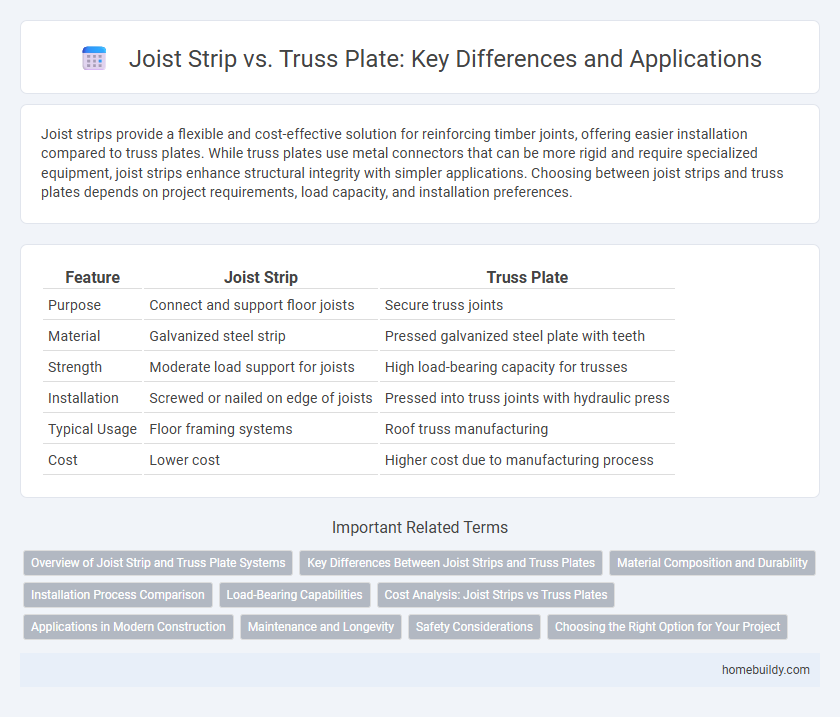Joist strips provide a flexible and cost-effective solution for reinforcing timber joints, offering easier installation compared to truss plates. While truss plates use metal connectors that can be more rigid and require specialized equipment, joist strips enhance structural integrity with simpler applications. Choosing between joist strips and truss plates depends on project requirements, load capacity, and installation preferences.
Table of Comparison
| Feature | Joist Strip | Truss Plate |
|---|---|---|
| Purpose | Connect and support floor joists | Secure truss joints |
| Material | Galvanized steel strip | Pressed galvanized steel plate with teeth |
| Strength | Moderate load support for joists | High load-bearing capacity for trusses |
| Installation | Screwed or nailed on edge of joists | Pressed into truss joints with hydraulic press |
| Typical Usage | Floor framing systems | Roof truss manufacturing |
| Cost | Lower cost | Higher cost due to manufacturing process |
Overview of Joist Strip and Truss Plate Systems
Joist strips are engineered connectors designed to reinforce and secure wood joists, enhancing floor and ceiling stability by distributing loads evenly across the structure. Truss plates, typically made of galvanized steel, are used to fasten timber trusses, providing rigid connections through their saw-toothed teeth pressed into the wood, ensuring structural integrity in roof and floor frameworks. Both systems optimize load transfer and structural performance, with joist strips focusing on linear joist reinforcement and truss plates specializing in joint stabilization within truss assemblies.
Key Differences Between Joist Strips and Truss Plates
Joist strips are long, thin metal connectors used primarily to reinforce wood joists by providing lateral support, whereas truss plates are flat, stamped steel connectors designed to join multiple wooden components in timber trusses. Joist strips mainly enhance load distribution along joists, while truss plates secure the overall framework by connecting multiple members at joints. The key difference lies in their application and shape: joist strips support linear joist stability, and truss plates facilitate structural truss assembly with strong, multi-point connections.
Material Composition and Durability
Joist strips are typically made from galvanized steel, offering enhanced corrosion resistance and flexibility in structural applications. Truss plates, on the other hand, are composed of thicker, high-strength steel designed for heavy load bearing and long-term durability in roof and floor truss systems. The material composition of joist strips favors adaptability and lightweight support, whereas truss plates prioritize maximum strength and structural integrity.
Installation Process Comparison
Joist strips require precise alignment and fastening using screws or nails along the beam's length to ensure proper load distribution, making the installation straightforward but labor-intensive. Truss plates involve a quicker process with metal connector plates pressed onto wood joints using specialized hydraulic equipment, offering rapid assembly with less manual alignment. The choice between joist strips and truss plates significantly impacts installation time and labor costs depending on project scale and equipment availability.
Load-Bearing Capabilities
Joist strips provide strong load-bearing support by distributing weight evenly across joists, ensuring structural stability in floor and ceiling systems. In contrast, truss plates are designed to connect truss members, optimizing load transfer at joint intersections but not intended for direct load-bearing across large spans. Understanding the distinct load-bearing capabilities of joist strips versus truss plates is critical for selecting appropriate components in construction projects focused on safety and durability.
Cost Analysis: Joist Strips vs Truss Plates
Joist strips offer a cost-effective alternative to truss plates by reducing material expenses and installation time on framing projects. Truss plates, typically made from galvanized steel, generally incur higher costs due to their manufacturing complexity and the need for specialized equipment during installation. Choosing joist strips can lead to significant budget savings in large-scale construction while maintaining structural integrity.
Applications in Modern Construction
Joist strips are primarily used in modern construction to reinforce and stabilize wooden joists, ensuring load distribution and preventing twisting. Truss plates, in contrast, serve as connector plates in prefabricated wood trusses, facilitating rapid assembly and structural integrity in roofs and floors. Both components enhance building durability but are selected based on specific framing needs and structural design preferences.
Maintenance and Longevity
Joist strips require minimal maintenance compared to truss plates, as their simpler design reduces potential corrosion and structural weaknesses over time. They offer enhanced longevity due to their durability and resistance to moisture infiltration, which commonly affects truss plates by causing rust and joint deterioration. Opting for joist strips can lead to lower long-term repair costs and improved structural integrity in wood framing.
Safety Considerations
Joist strips provide enhanced safety by offering consistent load distribution and reducing the risk of structural failure through their continuous support along joists. Truss plates, while effective for connecting timber members, may have limited safety margins due to potential plate displacement or bending under extreme loads. Prioritizing joist strips in construction minimizes hazards related to joint instability and improves overall framing integrity.
Choosing the Right Option for Your Project
Joist strips provide a simpler, cost-effective solution for connecting wood joists with easy installation, ideal for light to moderate loads in residential projects. Truss plates offer superior strength and stability through metal connectors, making them suitable for heavy structural demands and commercial construction. Selecting the right option depends on load requirements, budget constraints, and the specific building code regulations applicable to your project.
Joist strip vs Truss plate Infographic

 homebuildy.com
homebuildy.com